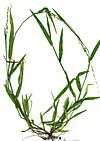Panicoideae
| Panicoideae | |
|---|---|

| |
| Miscanthus sinensis in Tonomine Highlands, Japan | |
| Scientific classification | |
| Kingdom: | Plantae |
| Clade: | Tracheophytes |
| Clade: | Angiosperms |
| Clade: | Monocots |
| Clade: | Commelinids |
| Order: | Poales |
| Family: | Poaceae |
| Clade: | PACMAD clade |
| Subfamily: | Panicoideae A.Braun (1864)
|
| Tribes | |
|
12 tribes, see text | |
| Synonyms[1] | |
| |
Panicoideae is the second-largest
switchgrass
.
C4 photosynthesis evolved independently a number of times in the subfamily, which presumably had a C3 ancestor.[2]
Description
The ligule has a fringe of hairs. The inflorescence is branched around a common axis. The spikelets are all alike with two bisexual florets that are joined below the glumes (the outer floral envelopes). The lower glume is shorter than the spikelet.[3]
Systematics and taxonomy
Within the
Gynerieae were formerly placed in Arundinoideae, and the basal lineage, the "centothecoid clade" with seven tribes, was formerly seen as separate subfamily, Centothecoideae.[1]
Phylogeny based on chloroplast DNA analyses, showing relationships of tribes within the subfamily (dashed lines indicate uncertain positions; C4 clades flagged):[1][2][4][5]
| Panicoideae | |
Gallery
- Diversity of Panicoideae
-
Woodoats (Chasmanthium latifolium, Chasmanthieae)
-
Spikelets of Loudetiopsis chrysothrix (Tristachyideae)
-
Gynerium sagittatum
-
Feathertop grass (Pennisetum villosum, Paniceae)
-
Cultivated maize or corn (Zea mays, Andropogoneae)
References
 Media related to Panicoideae at Wikimedia Commons
Media related to Panicoideae at Wikimedia Commons Data related to Panicoideae at Wikispecies
Data related to Panicoideae at Wikispecies






